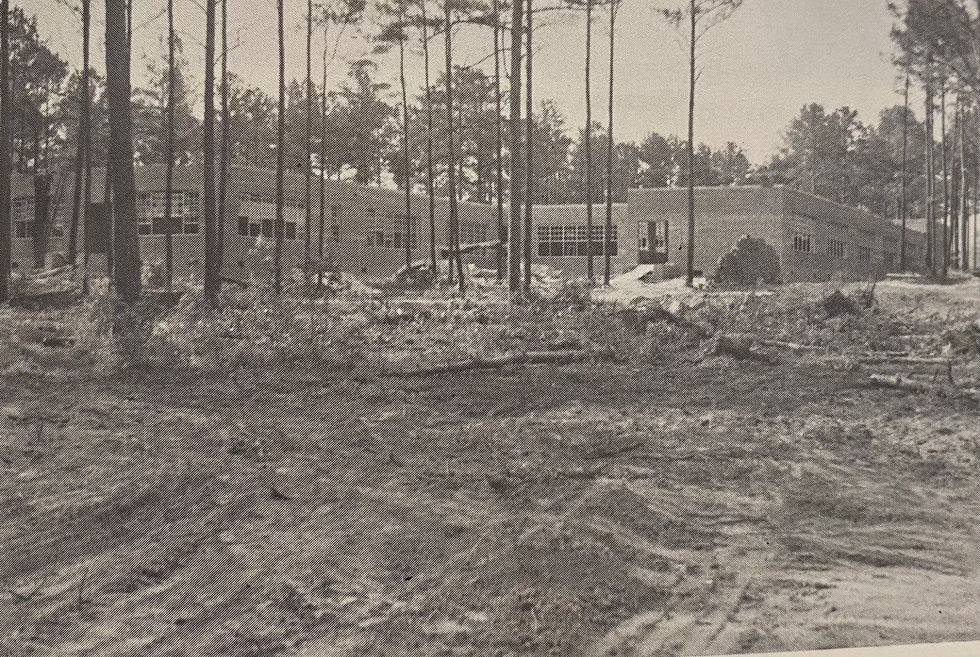1942 is the first year a listing for Warm Springs Road appears in the city directory. Warm Springs Road began where Talbotton Road splits at the intersection with the Southern Railway line and 12th Avenue. The road was lined largely with residences with a few commercial establishments scattered throughout. A number of planned subdivisions were platted and laid out during the 1930s and 1940s along the north side of Talbotton – Warm Springs Road. Many of these subdivisions took their names from the former estates from which they were subdivided, such as Sherwood Hall and Sherwood Forest, or from the previous property owner’s name, such as Chestnut Place, Evans Manor, and Brentwood. All but Chestnut Place were planned in the mid – to – late 1930s. Chestnut Place, Crestview, and Pageland were later subdivisions of the early 1940s.

Evans Manor and Sherwood Hall are located along the north side of Warm Springs Road between 14th and 17th Avenues. Both neighborhoods were originally a part of the Howard property. Matthew and Sarah Howard Evans, father of the renowned author, Augusta Jane Evans (St. Elmo), built a Greek Revival mansion (pictured above) in this area in 1830. The family lived in the home until 1840 when Mr. Evans suffered bankruptcy. The home and 150 acres were later sold back into the Howard family to Colonel Sherwood Connor Lindsay, who then called it "Sherwood Hall." It was later lived in by the widow Ann Lindsay Howard and her twelve children.
Sherwood Hall later became the site where the Georgia Woman Suffrage Association was founded by H. Augusta Howard, the youngest of the twelve children of Ann Lindsay Howard. The home was demolished in the 1940s. The estate was then subdivided in the 1930s and what is now commonly called, the Jordan-Johnson neighborhood, was developed.

The large majority of the houses are one-story, brick, and of modest sizing. The predominant architectural style is English Vernacular Revival with some Colonial Revival styles, as well. The brick commercial building at the five-points intersection on Warm Springs Road was built in the 1940s for a neighborhood grocery store.

Jordan High School was built in 1936 on a 19-acre lot that was a part of the Sherwood Hall estate. It was to replace the Secondary Industrial School in Waverly Terrace due to its programming becoming so successful and the number of students had outgrown the original two-story building. The new building and equipment cost $416,265 – 45% of which was contributed by the Public Works Administration (PWA) of the Roosevelt Administration. At that time, the school’s name was changed to Jordan Vocational School in honor of G. Gunby Jordan who had not only enthusiastically supported the idea of an industrial high school, but made it happen.

Shannon Hosiery Mill, Inc. was incorporated on November 8, 1938. The one-story mill sat on a 5 ½ acre lot at 1338 Talbotton Road. The cost of the buildings and the grounds was around $100,000. It was the only textile mill constructed in Columbus during the 1930s due to the Great Depression. Shannon Mill produced silk hosiery for the southeast region of the United States. The first president was N.S. Illges, and vice president was J.P. Illges. Other officers included W.T. Cothran as secretary and treasurer and E.C. Alford as assistant secretary. The mill soon saw difficult times. The shift from seamed to seamless hosiery doomed this and other local knitting mills. The mill facility was sold in 1958 to the Muscogee Board of Education for $250,000. The building was renovated and became a short-term home for the new junior college, Columbus College.
In 1988, the old mill building was demolished. In 2008, a historic marker for the mills was placed off Warm Springs Road. According to the historic marker, "more than 20,000 bricks from the mill's old smokestack were salvaged and cleaned by college faculty, staff and students and were used to line the inner arches of the Whitley Clock Tower, built in 1991 in the center of the CSU main campus. Today, Hannan Academy is located on the site where the old mill stood.

Crowded conditions at the Waverly Terrace School and other schools made transferring of students necessary. The new Superintendent, William Henry Shaw, led the School Board in acquiring eight new sites in 1946. A large enrollment of 8,000 students plus the projected expansion of the city limits in two years made the new locations necessary. Construction for Johnson Elementary School began in 1948 (pictured above). Johnnie Pearl “Onnie” Johnson founded what later became the PTA in Columbus and was the first woman to serve on the Muscogee County Board of Education. The new elementary school would be named for her in 1949. Onnie Johnson was also the mother of journalist, screenplay writer, and film producer, Nunnally Johnson, who is best known for his screenplay of Grapes of Wrath.
Residential neighborhoods continued north of the five points at 17th Avenue. Chestnut Place was planned between 17th Avenue and 34th Street. It was platted in 1941 and the majority of the homes have English Vernacular Revival or Colonial Revival details. The Crestview and Pageland neighborhoods are located further up Warm Springs Road between 34th Street and Woodruff Farm Road/Hilton Avenue.
While the edges of all of these neighborhoods are becoming more fragile due to the long-term road widening project on Talbotton - Warm Springs Road, the interior housing stock remains in fair to good condition. Historic Columbus can also now offer all of these properties the ability to receive a Facade or Rehab Loan for renovation work.
We hope you have enjoyed this series on the Northern Liberties! Coming in December: the history of the Columbus Fire Department













Kaiser OTC benefits provide members with discounts on over-the-counter medications, vitamins, and health essentials, promoting better health management and cost-effective wellness solutions.
Obituaries near me help you find recent death notices, providing information about funeral services, memorials, and tributes for loved ones in your area.
is traveluro legit? Many users have had mixed experiences with the platform, so it's important to read reviews and verify deals before booking.